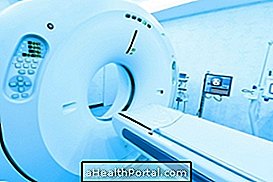In case of suspected endometriosis the gynecologist or the fertility specialist may request exams such as transvaginal ultrasound, CA125 exam or an MRI, but in some specific cases may be requested further tests that assess other areas of the body and the degree of impairment of these tissues.
Endometriosis is characterized by the presence of endometrial tissue, which is the tissue lining the uterus internally, in places outside the uterus such as the peritoneum, ovaries, bladder or intestines, for example. The gynecologist usually asks for these tests when the disease is suspected because there are symptoms such as very severe menstrual cramps, pain during intimate contact or difficulty getting pregnant.

The exams can be:
1. Vaginal and rectal examination
At the doctor's office the gynecologist observes the vagina with a speculum and, if you think there may be intestinal endometriosis, you may also see the rectum to look for cysts, which may indicate changes.
2. Pelvic or transvaginal ultrasound
Ultrasound can be done through the pelvis or transvaginally, being one of the first tests to investigate endometriosis, and it is necessary to completely empty the bowel before the exam by taking a laxative the day before. It is very useful for identifying ovarian endometriosis, which is one of the most common, but can also indicate if there is endometriosis in the bladder, ureters, vagina and rectum wall.
See the necessary preparation, price and how transvaginal ultrasound is made.
3. CA125 Blood Test
The CA 125 is not specific for endometriosis, but it can also be ordered and should be done on the 1st or 2nd day of the menstrual cycle. It can indicate the disease when the result is above 100 IU / mL.
Learn what the results of CA 125 can mean and how this exam is done.
4. Magnetic Resonance
It is usually ordered when there is suspicion of ovarian masses that need to be better evaluated and may also indicate deep endometriosis, which also affects the intestine. This examination may show scattered fibrosis and changes in the pelvis, subcutaneous tissue, abdominal wall, and even the surface of the diaphragm.
Know the price, types and how MRI is done.
5. Videolaparoscopy
Video-laparoscopy is the best test to identify endometriosis because it leaves no doubt about the disease, and also serves to check the staging of the disease, and allows a biopsy of the tissue to be checked for suspicion of malignancy.
This examination may also be requested after some time to see if it is having the expected effect, but it is not usually the physician's first choice because it is expensive and invasive, requiring anesthesia and first to discover other foci of endometriosis for the time the test is performed.
Find out how diagnostic videolaparoscopy is done, price and how recovery is done.
There are other complementary exams that may also be required, such as uro-resonance or rectal echoendoscopy, for example, which help to better observe where the endometrial tissue is growing to institute the best treatment that can be done with the continuous pill during 6 months. At this time, the doctor may repeat laparoscopy to evaluate the progression of the disease. In more severe cases, surgery may be needed to remove tissue that is growing outside the uterus, which can lead to infertility if the pelvic organs are removed.



















